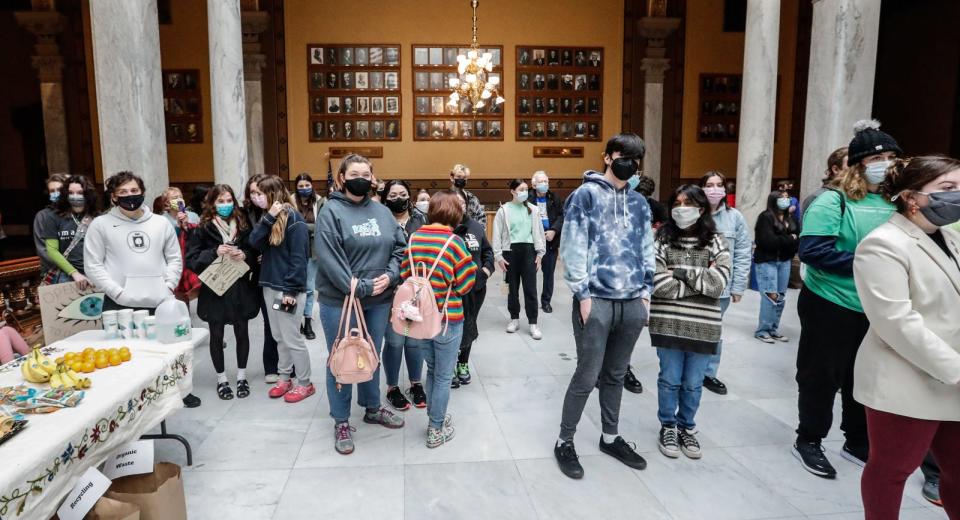Scrub Hub: How can teenagers help protect the environment?
Teenage climate activist Greta Thunberg and groups such as SustainUS have proven that environmental advocacy can reach across generational lines.
Younger age groups are becoming more active and vocal on environmental concerns and climate change advocacy. Audrey Richardson, from Greencastle, presides over an environmental organization at her high school and wrote in to the Scrub Hub to ask:
“What are some of the best ways for teenagers here in Indiana to help prevent huge environmental impacts?”
So for this edition, we set out to speak with academics, young advocates and NGOs to determine some of the best ways Hoosier high schoolers can get involved to help protect and save the environment.

The Short Answer
The consensus among those currently involved in environmental protection issues is that collective action is far more effective than individual actions, especially collective actions focused around issues currently within your high school or community.
Sidd Das, president of Indiana University’s Students for a New Green World , said his organization focused on specific goals for which they could easily hold the university accountable.
“By focusing on a specific goal, we’ve been able to make change, like the Climate Action Planning Committee,” Das said. “We decided to choose a goal easily tied to university operations that they can directly act on.”
Emily Plunkett, manager of outreach for the Hoosier Environment Council, reiterated the importance of working as a group.
“I really want to emphasize the power of working together with other students and organizations,” Plunkett said. “Collective action can do a lot more together than we can do alone.”
Plunkett referred to the youth-led Confront the Climate Crisis out of Lafayette as a great example of collective action at work.
The group worked with state legislators to draft bills to address climate change.
Scrub Hub:What are more environmentally friendly alternatives to a lawn of grass?
More:Indiana students demand action on climate change. Lawmakers respond with hard 'no.'
The Long Answer
Once a group is organized, Gabe Filippelli, executive director at the Environmental Resilience Institute of IU, said one good option is working within a school to change the culture around some environmental issues. He gave recycling as one example:
“This could involve setting up recycling programs,” Filippelli said. “This could look like not only a bin for aluminum cans only, but also involve the recycling of gently used clothing and items, and both could then wrap around a larger environmental message about reducing the use of things we have and refusing fast fashion, which has a tremendous negative impact on the environment.”
Plunkett and Das both suggested asking the school or institution to focus on climate friendly policies, which could include solar panels on schools and reducing energy emissions.
Generation 180, a clean energy-focused nonprofit, found Indiana ranked fifth in the nation for installed solar capacity for K-12 schools in a 2020 report.
This shows there is precedent for schools adopting solar energy, Plunkett said.
Das said working within the framework of our school is important. He recommended finding a topic or issue where conversation is already happening and pushing for something that already has some momentum.
Putting up flyers up and having conversations with other students, staff and teachers can be a good way to start building such momentum, he said.
“Personally a great stating point is just talking to as many people as you can that may have the same interests of goals,” Das said. “If there is conversation around, for example, composting or waste management, start there to push for something if there’s already a lot energy around those area.”
Scrub Hub:What are the do's and don'ts of recycling and how do I become better at recycling?
Filippelli and Plunkett both said voting is another effective way to take action.
“The main thing, and the most important climate actions are to talk about it and vote like it matters,” Filippelli said.
Holding voter registrations and encouraging the vote are also important actions for those not yet old enough to cast ballots, he said.
“We as individuals don’t have a whole lot of impact," he said, "but collectively we do.”
Preparing a future path for environmental advocacy is yet another way to help in the long term.
There are many ways to focus a passion to help: pursuing environmental studies in college, volunteering with local organizations, staying involved in climate action into graduate work, and taking jobs in areas that offer opportunities to make an impact. Taking advantage of science courses offered in high school and undertaking special projects within he school also can also be successful ways to help.
Outside of a school’s campus, there are local, residential actions that teens can organize.
Planting butterfly friendly and pollinator gardens and raising money for plantings that neighbors can add to their landscaping is one route. Hosting a climate scientist at a local library to speak with the community could be another.
“The more we talk about climate, the more it becomes normalized, and students are part of that process,” Filippelli said. “Highlighting it and getting in peoples’ faces — that’s all going to be for the good.”
Karl Schneider is an IndyStar environment reporter. You can reach him at karl.schneider@indystar.com. Follow him on Twitter @karlstartswithk
IndyStar's environmental reporting project is made possible through the generous support of the nonprofit Nina Mason Pulliam Charitable Trust.
This article originally appeared on Indianapolis Star: How can Hoosier teens help the environment?

